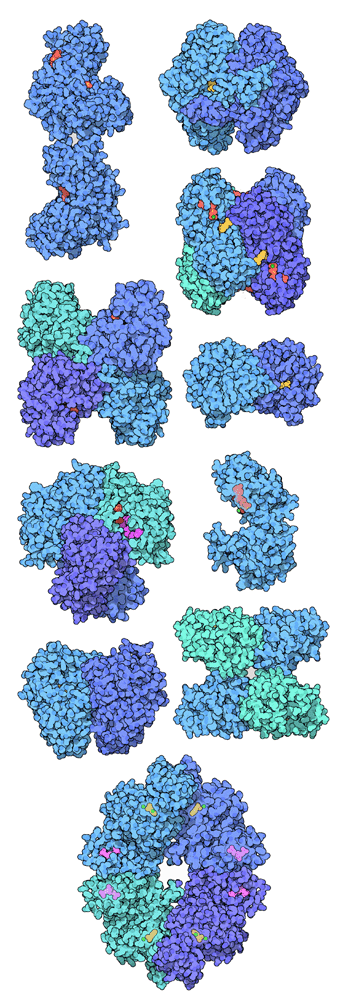|
Inhaltsübersicht | Nanomaschinen | Moleküle | Programme | Kurse | Fun | Links |
||
| > |
The Glycolytic Enzymes

The Glycolytic Enzymes
Glucose powers cells throughout your body. Glucose is a convenient fuel molecule because it is stable and soluble, so it is easy to transport through the blood from places where it is stored to places where it is needed. Glucose is packed with chemical energy, ready for the taking. In a test tube, you can burn glucose, forming carbon dioxide and water and a lot of light and heat. Our cells also burn glucose, but they do it in many small, well-controlled steps, so that they can capture the energy in more useable forms, such as ATP (adenosine triphosphate). Glycolysis (sugar-breaking) is the first process in the cellular combustion of glucose.Sugar Breaking
Glycolysis starts with a molecule of glucose and then performs ten stepwise chemical transformations. During this process, the sugar molecule is primed with two phosphates (using up two ATP molecules), then broken into two pieces, and finally reshaped and dehydrated, forming four ATP molecules in the process. Overall, glycolysis builds two new ATP molecules using the energy of this partial breakdown of sugar. The ATP may then be used to power molecular processes throughout the cell. In addition, one step in glycolysis also extracts four hydrogen atoms from the sugar molecule, which may be used for biosynthesis or to create additional chemical energy.After Glycolysis
The sixth enzyme in glycolysis removes several hydrogen atoms from the sugar, transferring them to the small carrier molecule NAD (nicotinamide adenine dinucleotide). These would build up if glycolysis was the only process under way, so cells have developed several different ways of dealing with them and balancing the books. Many cells, including most of our own, eventually combine them with oxygen to form water, building a lot of additional ATP in the process (see the Molecule of the Month on cytochrome c oxidase). Yeast cells use another enzyme (see the Molecule of the Month on alcohol dehydrogenase) to add the hydrogen atoms back to the broken sugar molecule, forming alcohol, which is excreted from the cell. Every time you drink a beer or have a glass of wine, you are drinking alcohol produced in this way. Overworked muscles, which are contracting too fast for enough oxygen to enter, add the hydrogen atoms back in a different way to form lactic acid. During anaerobic exercise, this lactic acid builds up and must be broken down later when oxygen becomes available.A Perfect Ten
Glycolysis is endlessly fascinating. In these ten enzymes, you can find examples of many of the important molecular processes that animate our cells. They have been perfected by evolution to perform their diverse chemical tasks quickly and efficiently--adding, removing, and shifting atoms without making mistakes. The pathway is carefully regulated, so that glucose is only broken down when energy is needed. Within glycolysis, you will find examples of allosteric enzymes that change shape during their function; enzymes that form covalent bonds to their substrates during the reaction; and enzymes that use metal ions or organic molecules to assist. Some of these enzymes are so efficient that they work faster than sugar molecules can get to them. The entire pathway is orchestrated so that each step proceeds smoothly, but not uncontrollably, towards the goal of capturing the energy as sugar is broken.Next: 1: Hexokinase
Last changed by: A.Honegger,